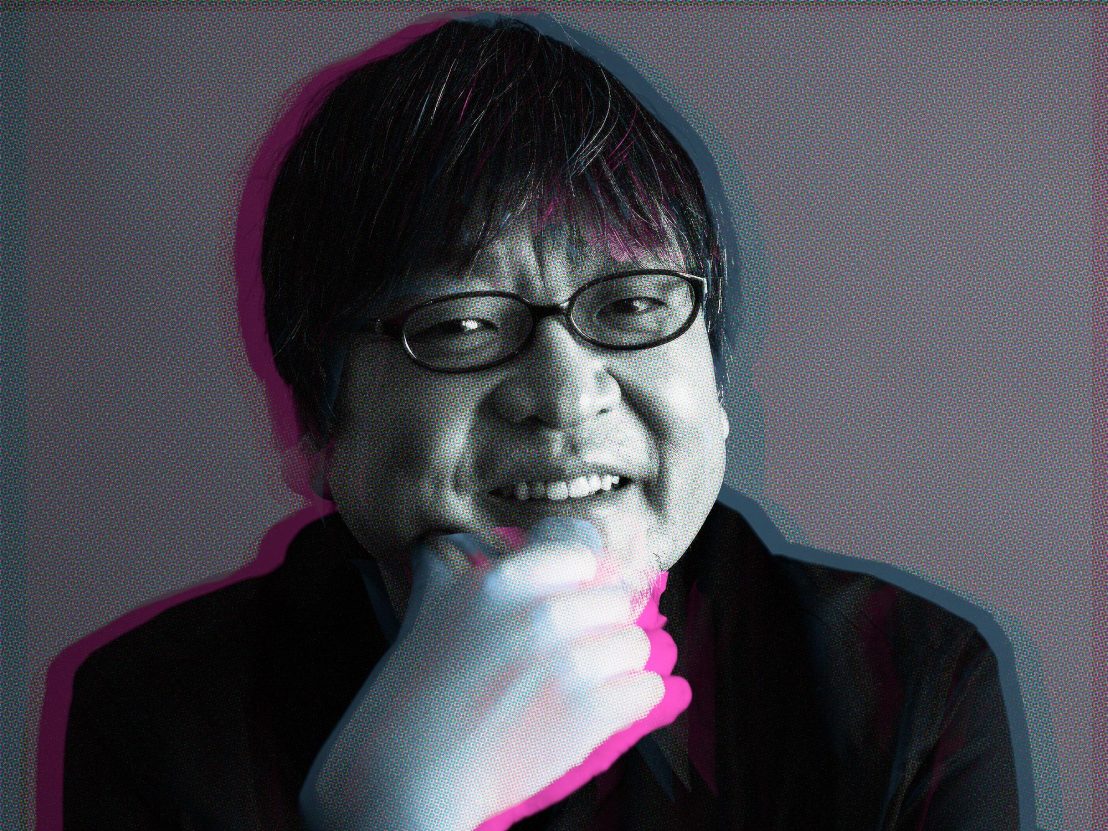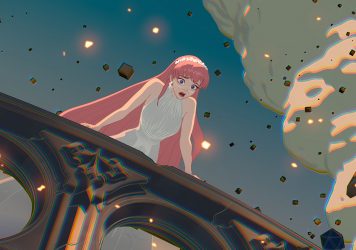
As Belle hits UK cinemas, the acclaimed Japanese director talks Digimon, virtual cityscapes, and parenthood in the digital age.
Mamoru Hosoda’s films have always concerned themselves with the lives of children, filled with anxieties and contemplations about the effect that the older generation has on the maturation of their offspring. He’s explored this from the perspective of the parent in fantasy films like Wolf Children, but also from that of the child, in that of Mirai.
Perhaps most striking, is his engagement with how the internet has an increasingly undeniable presence in that coming-of-age. And so his latest feature Belle feels like a culmination of all of the above, a ravishing update of Beauty and the Beast which reframes the classic story though digital culture, through a teenager finding herself through online relationships.
This interview was conducted with a translator, and edited for clarity.
LWLies: Compared to other films about the internet, Belle has quite an optimistic outlook about being online.
Mamoru Hosoda: You’re right. A lot of films based on around the internet tend to be dystopian. And whether that’s in a Spielberg or of the other directors that have done that, they tend to show the internet as being a problem in society. And then they use the problems that they see there to show some something about humanity. But I don’t really like that way of looking at the internet as sort of deliberately stirring up fear, and then using that to get a message across partly because I make animation and I have in mind, a young audience, I want to make something that’s going to help them. That was the same 20 years ago when I made Digimon Adventure and Summer Wars. I wanted to show the internet as a place where young people is a positive place for young people. And although the internet in real life is now full of trolls and slander, and in a way, does show some of the worst of humanity, I hope that young people will be able to change that and make it a better place.
You’ve spoken before about your family and personal experiences inspiring your past films. How much of your own experiences did you bring to Belle?
I suppose it wasn’t so much of an influence this time because my daughter is still only five and the protagonist of this film is in high school. But it was partly motivated by me starting to worry about when she grows up, when she gets to be a teenager and she faces all these teenage issues and how will she manage. The internet has changed a lot since I made Digimon and since I made Summer Wars, which were both based on the internet. Nowadays, there’s all this trolling that goes on online and parents, I think, tend to want to keep their children away from the internet if they can, but it’s something that young people today won’t be able to live without in their lives. They will need to be able to express themselves, and assert themselves in this space and we can’t stop them from using the internet. So we should try to encourage them and make it a positive space for them.
Speaking of Summer Wars – your previous representations of virtual reality, like OZ in that film, it appeared as something like a blank canvas, rather than the density of Belle.
It is very different to the internet world that I created in OZ for Summer Wars and in Digimon, and it’s different because the the position of the internet in our lives has changed a lot since then. In Digimon and in Summer Wars, the internet was designed as this blank space because it was still a new frontier. There was still gaps to fill in. It was still being developed and it was the world of the future. But now it’s extremely linked to our daily lives. Also OZ had one billion members of the community. Facebook at that point had fewer than one billion. But now Facebook, I think has got two billion members. So reality has overtaken fiction, and I needed to make a world that was bigger than that. So you have five billion members, but this is now where the internet is a second reality.
And how we go about showing that is to be this complex city scape. Of course, the one who has come up with the design for that complex city scape is the London architect Eric Wong. I found his portfolio online – I had no idea where he was, how old he was, what he did. It wasn’t until I contacted him that I found out that he was based in London. He was an architect, 28 years old, never worked in film, but he is so, so talented. The way we went about finding people to work on the film kind of mirrored the story in a way, because it’s a story about an unknown talent that is revealed online, and that’s exactly what happened with Eric Wong. He was exactly what we needed. I think if the Metaverse is going to take off, there’s going to be a lot of money out there. And if any big companies need a really good designer for their section of the Metaverse, drop me a line, I’ll give them Eric’s number.
The Beast’s castle stands apart from the rest of the film’s look. Did you and Eric discuss that as well?
I thought it would be better to separate the castle from the world of U and didn’t want to bring Eric’s conceptual design across to the castle. Because I wanted it to be apart, so I asked someone else to design that for me. That was Isamu Kamikokuryo, who was the art director on Final Fantasy 14 and 15. People look at the castle and they say, oh, it’s very reminiscent of Beauty and the Beast, it’s very Disney-like. But actually it’s more of a video game reference. And that’s why I asked him to do it.
About your work with the character designer, Jin Kim. Belle is quite reminiscent of a Disney princess as in the 1991 film, what lead to the other avatars looking so eclectically different?
So most of the avatars, a number of different designers designed them. And then we would pick the best one. Including with Belle and U, most of the designers involved, all had a go at designing Belle and U. And people say, ‘Oh, Jin Kim designed Belle, did you want a Disney-like character?’ Tomm Moore from Cartoon Saloon said, ‘Well, it’s very reminiscent of Glen Keane, the designer of Belle.’ But it wasn’t Glen Keane, it was Jin Kim. Though I don’t think that Jin Kim designs Disney-like characters. I think Disney is Jin Kim-like! Because he had such an influence on their work. And it was really exciting to see what he would design outside of that. Were there any particular avatars that you liked?
I loved Kamishin appearing as the dog holding the canoe.
Yeah, I wonder why Kamishin is a dog. It’s like, there’s no connection, but somehow through the avatar, you learn more about the character. It’s like, I was talking about this earlier, it’s like going to karaoke, the songs people choose tell you an awful lot about them. And sometimes you start to see them as a different person because they choose particular songs. It’s like that. And they’ll choose a certain song and you think, whoa, there’s a lot more to this person than I thought.
Speaking of songs, how did you decide what Belle’s music should sound like, as something that might find viral fame?
Just like Eric Wong created this new world in designing in U, in the real world, we have countries, we have culture gaps that are quite difficult to overcome, but I thought if I was creating an online world of five billion people, there would be no countries and no borders, and it would be a world where people shared common values and where people could agree on what was beautiful, what sounded beautiful, what music was without any kind of bias. The music really needed to fit that idea. So be beyond any sort of borders and be something that people from any country, any age could enjoy. That was what would allow Belle to become really the focus of this online world.
But if you give that brief to musicians, it’s actually something really, really difficult to do. They start thinking, well, do we go for inspiration to the US charts? But you can’t do that because then you’re going to get something that sounds very American. They really needed something much more universal. The question was how to go about doing that. I think they needed to come up with something new, but I think it was definitely not an easy thing to do.
Belle uses more CG animation than in any of your past films, particularly with the characters. How did you manage the balance?
With this film, I’ve used hand drawing and CG, but I’ve differentiated along conceptual lines. So the real world is hand drawn and then the virtual world of U is done using CG. So the technique I’ve differentiated the techniques based on the two different worlds. I can’t think of any other films where that’s been done either in Japan or in the US. Normally what you do is you use hand drawing for the easy bits, and then when it gets complicated, you start to using the CG. But sometimes that ends up being a bit like trying to get a square peg in a round hole, and they don’t quite gel, but from the outset I knew I was going to be using CG.
I thought that it matched really well with the story, the way that the hand drawing and the CG can sit side by side in these two worlds. The method of expression matches the concept of the film. Having said that it’s not something I’ll be able to repeat in whatever I do next, I’ll have to think of a new way of working.
Published 2 Feb 2022

A tale as old as time gets a cyberspace makeover in Mamoru Hosoda’s reimagining of Beauty and the Beast.

By Matt Turner
The recent Edge of Frame Weekender showcased bold contemporary visions and rarely seen masterpieces.